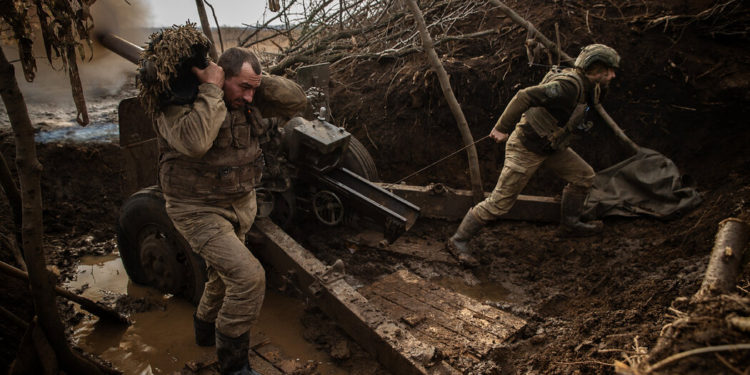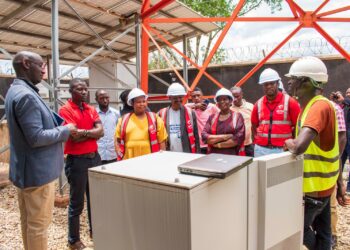By THE NEW YORK TIMES
Even from a few miles away, the death rattle of another Ukrainian city echoed through the mist and fog. Russian warplanes were dropping more thousand-pound bombs on Avdiivka in eastern Ukraine, reducing an already battered city to rubble and ashes.
Since Jan. 1, President Vladimir V. Putin’s forces have dropped around one million pounds of aerial bombs on an area encompassing just 12 square miles, according to estimates by Ukrainian officials and British intelligence.
Avdiivka fell to the Russians on Saturday, after some of the most horrific and destructive fighting of the two-year-old war. In the end, Russia’s superior firepower and manpower overwhelmed Ukrainian forces over many months, even as Russia incurred a staggering number of casualties.
The Ukrainians withdrew under withering bombardment, fighting intense battles across ruined streets to break out of Russian attempts to encircle them. Russian warplanes bombed the hulking coke-processing plant on Avdiivka’s northern outskirts, using incendiary munitions to blow up fuel tanks at the plant, unleashing a toxic smog, according to Ukrainian soldiers fighting in the plant.
“Avdiivka is a constant barrage of aviation bombs,” Maksym Zhorin, deputy commander of the 3rd Special Assault Brigade, said on Friday. “It feels like the largest number of air bombs on such a stretch of land in the entire history of humanity. These bombs completely obliterate any positions. All buildings, structures, after just one airstrike, turn into craters.”
Astonishingly, more than 900 civilians had remained in the city, according to city administrators and the police — from a prewar population of 30,000 — living subterranean lives and surviving on food and supplies brought in by aid workers.
In the aftermath of the Ukrainian withdrawal, their fate was unknown.
“I have not been able to reach anyone for the past two days,” said Ihor Fir, a mechanic at the coke plant before it was destroyed, who was regularly risking his life to bring food, water and medicine to the civilians still living in Avdiivka and surrounding villages.
The last messages he received were from people desperate to escape, but unable to move under the constant shelling. Any survivors in the city, he said, were likely to be stranded. “There is no way for them to get out,” he said by phone on Saturday. “The road is under shelling.”
In an interview last week, Mr. Fir called conditions in Avdiivka “just horrible” and shared videos and photos of the devastation from his last trip into the city earlier this month. “There are ruins everywhere,” he said. “There isn’t a single house left untouched.”
Vitalii Barabash, the head of the Avdiivka military administration, said that multistory buildings “collapse like card houses,” adding, “Very often people remain under the rubble and, unfortunately, we cannot reach them.”
He estimated earlier this month that at least 800 guided bombs, each weighing between 550 and 3,300 pounds, had been dropped this year within the city limits. His claim could not be independently confirmed, but the British intelligence agency reported that in just four weeks, Russian warplanes dropped some 600 guided bombs on Avdiivka, with as many as 50 recorded in a single day.
The Russian tactics in Avdiivka were “a textbook punishment campaign, which they have orchestrated in Chechnya, Syria, Ukraine and even Afghanistan,” said Seth. G. Jones, a military analyst at the Center for Strategic and International Studies.
“It is designed,” he said, “to raise the societal costs of continued resistance and coerce the adversary and its population to give up.” Mr. Putin hailed the capture of Avdiivka as “an important victory,” the Kremlin said on Saturday.
There are no reliable statistics on the number of soldiers or civilians killed in the bombardments.
Mr. Fir shared pictures of the ruins of a supermarket hit by a bomb last week as 15 people sheltered in the basement. At least 10 of them died and remained buried in the rubble, he said.
“A person goes to sleep and does not wake up,” he said as he traveled to bring food and water to refugees in a village about three miles from Avdiivka. As the Russians advanced to the north and west, they flattened that village as well. At least half the homes where the refugees took shelter were bombed.
Avdiivka has been on the front line of fighting for a decade, dating to Russia’s first bid to cleave off a part of eastern Ukraine, in 2014. The constant skirmishes often receded into the background. Life for the 30,000 residents could be difficult, but manageable.
The city was known then for the sparkling blue lakes that filled former quarries. Residents were proud and determined to stay and live an active life despite being on the front line. At the annual festival to celebrate the city’s founding in 1956, the loud music would drown out distant shelling.
“Avdііvka was a good, beautiful town,” said Victoria, 52, who was one of the last civilians to escape Avdiivka earlier this month and asked that her family name not be used because she feared for her life. “We lived. We worked. Everything was good for us.”
That all ended on Feb. 24, 2022, when the Kremlin launched its full-scale invasion.
The Kremlin immediately set its sights on Avdiivka, shelling from a distance and skirmishing in industrial zones, but failed time and again to break through Ukrainian fortifications.
After his home was destroyed last May, Mr. Fir fled with his wife. By June, there were fewer than 2,000 civilians in Avdiivka, most of them living largely underground.
The hulking industrial plant with its warren of Soviet-era nuclear fallout shelters offered refuge for people as fighting intensified. But eventually civilians were evacuated and the plant became a fortress for the Ukrainian military. Civilians who remained in Avdiivka mostly sheltered in basements.
Victoria refused to evacuate. “My husband was killed by a bomb on July 15, 2022,” she said. He was getting water from a well when he was blown apart, she said. When her mother also died, she had only her dog and her mother’s dog to keep her company.
“I did not want to leave because the graves of my relatives remained here,” she said.
Dozens of interviews over the last two years show that the reasons civilians stay behind in war zones are complicated.
“I just put up with it,” Victoria said. “I thought sooner or later, it had to end somehow. It didn’t stop — it just got worse and worse.”
In early October, Russia launched the first of a series of large-scale offensives aimed at broadly encircling Avdiivka.
Tens of thousands of Russian soldiers were killed and wounded in repeated waves of assaults, according to Ukrainian and Western officials. Ukraine, despite suffering its own losses, held on.
The Russians devised a new plan this winter, using a two-mile-long drainage tunnel to burrow under Ukrainian fortifications, infiltrate a neighborhood in the southeastern part of the city and ambush the Ukrainians.
As the Russians advanced, some civilians escaped on foot to the city center, where they were met by a special police unit, known as the White Helmets, to be evacuated.
The Ukrainian police shared a video of an evacuation last month, with civilians describing chaos and bloodshed as Russians entered their neighborhood.
“When the Russian troops entered, it wasn’t just a nightmare, it was some kind of Armageddon,” an old man said. “Blood, deaths, looting. Thirty-four years in the mines, and everything I did for my family, it’s all destroyed.”
Their accounts could not be independently verified.
But dozens of horror stories were relayed by residents who managed to get out as Russian forces fought their way deeper into the city.
Viktor Hrydin, 87, who helped build the coke plant that has long been Avdiivka’s economic engine, refused to go even as his world burned around him. A neighbor, Tetiana, 52, moved in to take care of him.
On Christmas, a bomb exploded at their home.
“I was covered in blood,” Viktor said in an interview at a hospital where he was recovering. “And her blood was flowing like a river.”
Tetiana’s leg was ripped apart, and a bullet had torn through his arm. Still, he was able to pull her to safety. She was recovering in a room with seven other heavily injured women. They were alive, but their lives were shattered.
“In old age, I was left with nothing,” Viktor said.
Even after two years of unfathomable violence, Victoria was not prepared for Russia’s final bid to annihilate her city.
Residents on Chernyshevskoho Street, near the entrance of the city, she said, “were bombed so badly that people just wrapped themselves in white sheets” and wandered out into the open, hoping to find a volunteer to take them out.
“People were dying there every day,” she said. “There’s nothing you can do to escape, no basement, nothing.”
“I realized that if I didn’t leave, “she said, “I would just go crazy.”
She was one of the last people to make it out of Avdiivka, on Feb. 2, before evacuation became impossible.
Liubov Sholudko contributed reporting from outside Avdiivka. Nataliia Novosolova and Anastasia Kuznietsova contributed reporting.







Discussion about this post